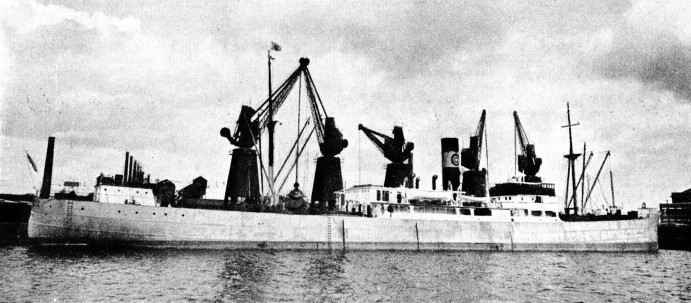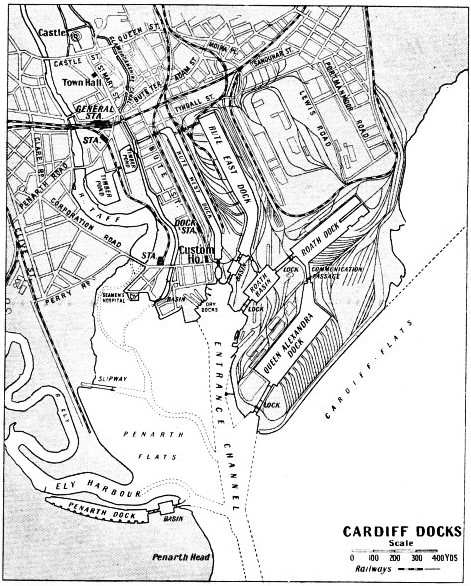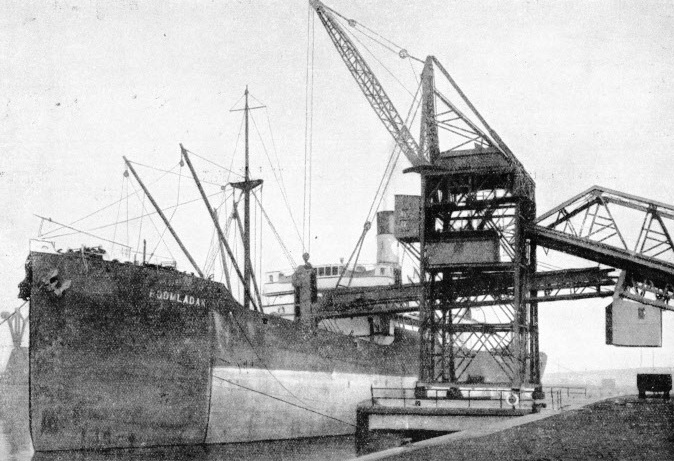

© Shipping Wonders of the World 2012-

Cardiff
Famous for its exports of coal, Cardiff owes its importance to the proximity of the coal-

THE DISCHARGING IRON ORE at Cardiff Docks. Iron ore is imported from Sweden and Spain, and iron and steel rails are among the principal exports of Cardiff. The Swedish ship C. F. Liljevalch (shown above) has a gross tonnage of 5,492. She is 349 ft. 5 in. in length, and has a beam of 52 ft. 3 in. and a moulded depth of 34 ft. 1 in., with a corresponding draught of 25 ft. 7 in.
CARDIFF, the county town of Glamorganshire and the commercial capital of Wales, has risen from a sleepy, old-
Three waterways, the Clyde, the Mersey and the Bristol Channel, carry most of the ships that trade with the west coast of Great Britain. Cardiff is on the southernmost of these waterways and is easily reached by ships from North and South America, Western Europe and the Mediterranean. It is also well placed for the coasting trade, particularly to the south of Ireland and the west coast of England and Scotland. The docks comprise 165 acres of deep water with over seven miles of quays, and are the last word in efficiency.
From seaward the approach to Cardiff, up the Bristol Channel, is most beautiful; the hills of Somerset to starboard and the hills of Glamorgan to port rise above the restless tides of the wide channel. The docks do not straggle untidily along the shore, but are compactly built on the tip of low-
The bold headland of Penarth, on the western side of the estuary, is at the eastern end of a delightful bay facing the Bristol Channel. Citizens of Cardiff reach the bay and its esplanade by bus from the heart of the city. They may. watch the shipping in the Channel, enjoy views of the English coast, or fish from the pier. In summer, pleasure steamers start from Cardiff Pier, at the
end of Bute Street, pick up passengers at Penarth Pier, and go to Weston-
Penarth Head shelters the city from the prevailing winds, and the dust from the coal tips at the docks does not disfigure the Portland stone of the public buildings. There are no coal mines within five miles of the city and, as the docks are separated from the heart of the town by the length of Bute Street, Cardiff is unusually clean for a great port. It is noteworthy also for the magnificence of its public buildings and for the number of its parks.
The offices of the shipping companies, of industrial and commercial firms, and the Bute Docks Offices (the headquarters of the Great Western Railway Company’s Docks Department), are in the docks area. The civic centre, adjoins Cardiff Castle and extends on the northeastern side of that noble building, which is the nucleus of both city and port. Built on the site of a Roman fort, the castle is not a crumbling relic of the past, but is the seat of the Marquess of Bute, whose family built the first docks.
The expansion of Cardiff from a place little larger than a village into a port of world renown was not the result of gradual growth. Prosperity was created by the foresight and enterprise of the men who built the docks on the marshy foreshore and brought steam coal from the mines to the ships which carried the fuel to distant countries. The port has not the advantage of a natural deep-
The shore from the mouth of the Taff to the junction of the Rivers Wye and Severn is low, but the western shore, beginning from Penarth Head, is undulating with cliffs. Northward of Cardiff the Taff has cut an outlet to the sea through the ridge that forms the edge of the coal-
The first wharf was built in 1263, but because of the rise and fall of the tide, and the remoteness of Cardiff from populous areas, the town did not grow. In addition to the upper quay there was a lower one for passenger vessels which sailed across the Channel to Bristol and other ports. In the eighteenth century the iron ore in the country behind Cardiff became important, and men came from the Midlands of England to mine the ore and the smelt, using the coal found near by. The smelted iron was loaded on to pack mules and carried to the town to be shipped in small craft; and this traffic outgrew the method of transport, Because of the lack of transport facilities there seemed no prospect of Cardiff’s ever becoming a coal port. Transport was so difficult that in 1782 a Customs collector reported that “we have no coals exported from this port, nor ever shall, as it would be too expensive to bring it down here from the internal part of the country”.
The demand for iron increased, and the Glamorganshire Canal was cut in 1798 to provide a method of transport in place of the pack mules. This improved the port, but even in 1801 the population was only about 1,870, and there was no sign of the beginning of the city of some 225,000 people which exists to-
When the demand for coal became heavy, such rapid progress was made that Cardiff outstripped her rivals and became the premier coal port of the world. Her prosperity depended upon fleets of humble steamships, and she had not the traditions of sail, nor was she ever the home port of ocean greyhounds. She became the port for tramps and colliers, which carried cargoes of the best coal in the world.
Prosperity was founded by the second Marquess of Bute, who put the family fortune of £350,000 into building what is now known as Bute West Dock. This is used to-

THE COMMERCIAL DRY DOCK, owned by the Great Western Railway, is 600 feet in length and has a width at the entrance of 60 feet. It is the largest dry dock in the port of Cardiff. The 15-
The ships which carried coal from Cardiff were built elsewhere, but as Welsh coal was always in demand, shipowners opened offices in the port, which quickly became prominent in the open carrying trade. The first locally-
Cardiff soon became the great centre from which coal was sold to foreign consumers. Although this trade has passed its peak, Cardiff is one of the few ports in Great Britain at which the exports are greatly in excess of the imports.
Except for Bute West Dock, the oldest of them all, the docks are linked by communication locks. Since 1922 they have been controlled by the Great Western Railway, which took over the docks and most of the railways in South Wales, and installed new plant and made many improvements. The largest dock, Queen Alexandra Dock (52 acres), is the outermost one. It is entered by a lock 850 feet long, 90 feet wide and having a depth of 42 feet at high water. A junction links it with Roath Dock (33 acres), the two forming one dock, with a combined area of 85 acres, which is among the largest walled docks in the world. A lock leads from Roath Dock into Roath Basin (13 acres), which has two other locks, one being the entrance from the harbour channel and the other leading to Bute East Dock (46J acres), at right angles to it.
This dock also has a basin and locks through which vessels enter from the harbour channel. Parallel with it is Bute West Dock, with its basin (20½ acres). Bute Street is the western border of the docks, and' is known to seamen in many ports. The area between this long thoroughfare and the narrow Glamorganshire Canal is occupied by shops, offices, business premises and houses. The pier and the Mount Stuart Dry Docks are at the tip of the peninsula. Still farther west is the River Taff, the Seamen’s Hospital being at the end of a spit of land, on the northern end of which are timber yards, where much of the timber which is imported to Cardiff is stored.
A great part of this timber is used in the neighbouring mines, and about 300,000 tons are imported yearly by ships from the White Sea, the Baltic, Norway, Sweden, Newfoundland and Canada.
Cardiff is one of the chief milling ports of Great Britain. Large quantities of grain are landed at the mills and stores completed in 1933 at Roath Dock by Spillers, Ltd. Adjoining the same dock are the extensive works of the famous Dowlais (Cardiff) Steel Works, for Cardiff has become an industrial city, with a wide range of manufactures. Cattle are landed at a special berth in Roath Dock adjoining the lairages (pens), near which are abattoirs and chill rooms. The port is one of the few in Great Britain into which live cattle may be imported. The cattle are shipped from Ireland, Canada and South Africa, and an auction ring is provided so that the beasts can be sold soon after they are landed and delivered to the buyer within a few hours.
 Cold stores are in Queen Alexandra Dock. Large vessels can berth alongside and discharge direct into the stores or into refrigerator railway vans, for the docks are surrounded by a network of railway sidings. Fruit is another important import, as are vegetables — Cardiff is a great potato importing centre — and provisions and canned food. These foods are brought by a variety of ships from far and near.
Cold stores are in Queen Alexandra Dock. Large vessels can berth alongside and discharge direct into the stores or into refrigerator railway vans, for the docks are surrounded by a network of railway sidings. Fruit is another important import, as are vegetables — Cardiff is a great potato importing centre — and provisions and canned food. These foods are brought by a variety of ships from far and near.
CARDIFF’S DOCKS have a total area of about 165 acres, and quays which extend for more than 7 miles. Queen Alexandra Dock (52 acres) is the largest and most modern of them all. The oldest is Bute West Dock (20½ acres), which was opened in 1839. Although the freighter is the mainstay of the port, the docks can berth large passenger liners. Representative ships of nearly every shipping company in the world call at Cardiff for coal, and a considerable coastal trade is handled by the port.
In the docks may be seen a vessel from Dublin with potatoes, another from Valencia with potatoes and oranges, one from San Francisco with canned pilchards, and one from Los Angeles with grapefruit and oranges or canned pears. Fruit is sold at the Fruit Exchange and sent by railway and road to its destination. The South Wales miners are among the largest consumers of fruit in the kingdom, and Cardiff, as well as supplying the miners, is the importing centre for the Midlands. More than a quarter of the population of England and Wales is concentrated within a 90-
Cardiff’s coastal trade is considerable. Among the lines on this service are Coast Lines, whose vessels link the port with Aberdeen, Leith, Middlesbrough, Newcastle, Hull, London, Portsmouth, Southampton, Plymouth and Liverpool. The Sloan Line runs ships to Belfast and Glasgow, the Gilchrist steamers go to Liverpool and Birkenhead. The City of Cork Steam Packet Co. and the Limerick Steamship Co. are also represented.
The dock equipment for dealing with all these ships is elaborate. The coaling appliances include 31 cranes and hoists, with two electric belt conveyers, 21 of the appliances being able to ship 20-
Apart from coal, which is the chief item of export, other exports are normally in excess of 500,000 tons a year. The principal items are patent fuel, steel rails, iron, carriage and wagon work, and general merchandise.
Dry docks, pontoons and slipways which can accommodate about twenty vessels add to the facilities for ship-
Commercial Capital of Wales
In addition to the Bute Docks, the docks at Penarth and at Barry Island are now included in the Customs Port of Cardiff, although at one time they were rivals. Penarth Dock is tucked away behind the headland opposite the Bute Docks, and is a development of the natural harbour formed by the estuary of the River Ely, the dock and the basin having an area of 261 acres. The tidal harbour, which dries out at low water, has an area of 55 acres. Barry Docks are about nine miles southwest of Cardiff, the total area being 114 acres, with 41 acres of timber ponds. They consist of Dock No. 1, opened in 1889 at the same time as the Basin (Dock No. 3), and Dock No. 2, which was opened in 1898 and is entered from the first dock. The entrances are close to deep water, under the high land of Barry Island, and are protected by two breakwaters. These docks have shipped over 11,000,000 tons of coal in a year, and the total traffic is almost equal to that of the Bute Docks. The dry docks include one 860 feet long. Of the 33 coal hoists 17 can handle 20-
The development of the docks which made Cardiff into a great port also.made her the commercial capital of Wales, and her splendid public buildings are among the finest in the world.
In the City Hall there is a bronze tablet commemorating Captain Scott, who sailed in the Terra Nova from Cardiff on his last voyage. In the Technical College are the School of Navigation, the School of Marine Engineering, and also the Smith Junior Nautical School.

A MODERN COAL-
You can read more on “Liverpool”, “The Port of Bristol” and “Progress of the Motorship” on this website.